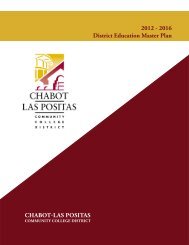City College of San Francisco - California Competes
City College of San Francisco - California Competes
City College of San Francisco - California Competes
Create successful ePaper yourself
Turn your PDF publications into a flip-book with our unique Google optimized e-Paper software.
STANDARD II.A<br />
how departmental needs were evaluated (e.g.,<br />
use <strong>of</strong> focus groups, advisory committee recommendations,<br />
or institutional data) and how the<br />
department will meet the eight Requirements <strong>of</strong><br />
Uses <strong>of</strong> Funds. Proposals also must demonstrate<br />
the use <strong>of</strong> <strong>College</strong> Performance Indicators data<br />
in the proposal planning process and in the<br />
assessment <strong>of</strong> performance outcomes.<br />
There are also faculty-initiated efforts to evaluate<br />
instructional programs. For example, beginning<br />
four years ago, several departments and one<br />
program (i.e., Architecture, Art, Graphic<br />
Communications, Photography, and Multimedia<br />
Studies) began a collaborative effort to develop<br />
courses that could be taught in any <strong>of</strong> the participating<br />
departments. After review <strong>of</strong> the course<br />
<strong>of</strong>ferings for each department, a common<br />
instructional need was discovered that was not<br />
adequately addressed by any <strong>of</strong> the departments<br />
involved. As a result <strong>of</strong> these initial discussions,<br />
the Design Collaborative was established. Those<br />
courses developed by the Design Collaborative<br />
have now been <strong>of</strong>fered for two years and have<br />
been evaluated by participating faculty with<br />
regard to the learning outcomes and student<br />
competency.<br />
II.A.2.g. If an institution uses departmental<br />
course and/or program examinations, it validates<br />
their effectiveness in measuring student learning<br />
and minimizes test biases.<br />
During Fall 2004, all instructional departments<br />
were surveyed in order to assess the number<br />
<strong>of</strong> departments using common course examinations.<br />
The following courses were found to<br />
have common exams:<br />
Accounting 1 and 2<br />
Broadcasting 120<br />
Chemistry 101A and Chemistry 32L<br />
English 94<br />
English as a Second Language (Credit<br />
Courses) 110, 120, 130, 140, 150, and 82<br />
English as a Second Language (Noncredit<br />
Courses) N3200, N3400, and N3600<br />
Spanish 1A and French 1, 1A, 1B, 2, 2B<br />
Math E1<br />
As a part <strong>of</strong> this survey, department chairpersons<br />
were also asked to provide information about the<br />
validity and reliability <strong>of</strong> the testing instruments<br />
employed, steps taken to avoid cultural bias in<br />
the construction <strong>of</strong> the test questions, and to<br />
provide any information regarding culturally<br />
biased questions if applicable.<br />
Results from this survey indicated that departments<br />
ensure validity <strong>of</strong> their test instruments<br />
with a variety <strong>of</strong> means. The Business Department<br />
engages all faculty in the development<br />
<strong>of</strong> test questions used in their Accounting 1<br />
and Accounting 2 courses. The Broadcasting<br />
Department also relies on those faculty teaching<br />
Broadcasting 120 to review the test questions<br />
and revise when needed. Faculty teaching<br />
Chemistry 101A collaborate when writing test<br />
questions, consult past instructors about student<br />
performance and <strong>of</strong>ten consult other instructors<br />
about test questions. The English Department<br />
compares student performance in the English 94<br />
common exam to student performance in class.<br />
The ESL Department compares student scores to<br />
the instructor’s expectations regarding the student’s<br />
pr<strong>of</strong>iciency in the subject. Credit ESL final<br />
exam scores for students are compared to their<br />
scores for previous tests in the course and final<br />
course grades. Foreign language instructors have<br />
adopted national examinations to evaluate their<br />
students. The Math Department uses Math E1<br />
as a predictor <strong>of</strong> success for Math 840. Some <strong>of</strong><br />
these departments use statistical data to establish<br />
validity and reliability <strong>of</strong> their test instruments.<br />
A variety <strong>of</strong> methods are also used to avoid cultural<br />
bias in the development <strong>of</strong> test questions.<br />
Some departments make a conscious effort to<br />
ensure that faculty developing test questions<br />
represent diverse cultural backgrounds. Other<br />
departments have provided faculty involved in<br />
developing test questions workshops on the<br />
topic <strong>of</strong> cultural diversity, and specifically, how<br />
to eliminate cultural bias from test questions.<br />
CITY COLLEGE OF SAN FRANCISCO<br />
121







